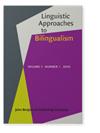二语汉语动结构中虚代词和显性代词的解释
IF 1.8
2区 文学
0 LANGUAGE & LINGUISTICS
引用次数: 0
摘要
本实验研究考察了以英语为母语的汉语为第二语言的人对虚代词和显性代词解释的习得情况。研究发现了学习者母语中不存在的一种语言现象:汉语结果结构中嵌入主语位置的空元只能指主句主语,而同一位置的显性代词既可以指主句主语,也可以指语篇中的另一个实体。因此,习得任务包括学习一个新的功能语素、一个空素以及限制其在结果结构中的解释。我们对59名不同水平的汉语第二语言学习者和51名以普通话为母语的人进行了真值判断任务的测试。除了一种情况外,学习者表现出的口译模式在统计上与母语人士的口译模式没有区别。我们认为,我们的研究结果表明,即使对空元素解释的限制不能从母语转移,但在很大程度上成功地获得了必要的形式解释。本文章由计算机程序翻译,如有差异,请以英文原文为准。
Null and overt pronoun interpretation in L2 Mandarin resultative constructions
This experimental study examines the acquisition of null and overt pronoun interpretations in Chinese as a second
language by native speakers of English. A linguistic phenomenon not present in the native language of the learners is identified:
the null element in the embedded subject position of Mandarin resultative constructions can only refer to the main-clause subject,
while an overt pronoun in the same position can refer both to the main-clause subject and to another entity in the discourse. Thus
the acquisition task includes learning a new functional morpheme, a null element, as well as constraining its interpretation in
the resultative construction. We tested 59 L2 learners of Chinese at different proficiency levels and 51 native Mandarin speakers
on a Truth Value Judgment Task. The learners showed a pattern of interpretation that was statistically indistinguishable from the
native speakers’ in all but one context. We argue that our findings point to largely successful acquisition of the requisite
proform interpretations, even though the restrictions on the interpretation of null elements cannot be transferred from the native
language.
求助全文
通过发布文献求助,成功后即可免费获取论文全文。
去求助
来源期刊

Linguistic Approaches To Bilingualism
Social Sciences-Linguistics and Language
CiteScore
3.20
自引率
9.10%
发文量
24
期刊介绍:
LAB provides an outlet for cutting-edge, contemporary studies on bilingualism. LAB assumes a broad definition of bilingualism, including: adult L2 acquisition, simultaneous child bilingualism, child L2 acquisition, adult heritage speaker competence, L1 attrition in L2/Ln environments, and adult L3/Ln acquisition. LAB solicits high quality articles of original research assuming any cognitive science approach to understanding the mental representation of bilingual language competence and performance, including cognitive linguistics, emergentism/connectionism, generative theories, psycholinguistic and processing accounts, and covering typical and atypical populations.
 求助内容:
求助内容: 应助结果提醒方式:
应助结果提醒方式:


